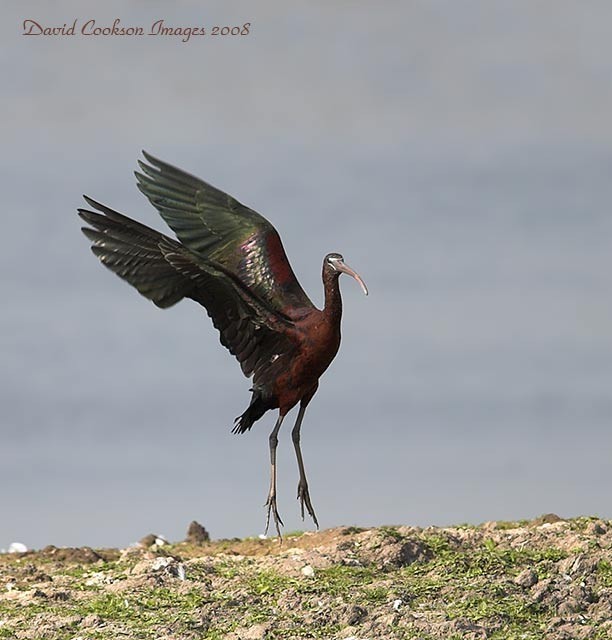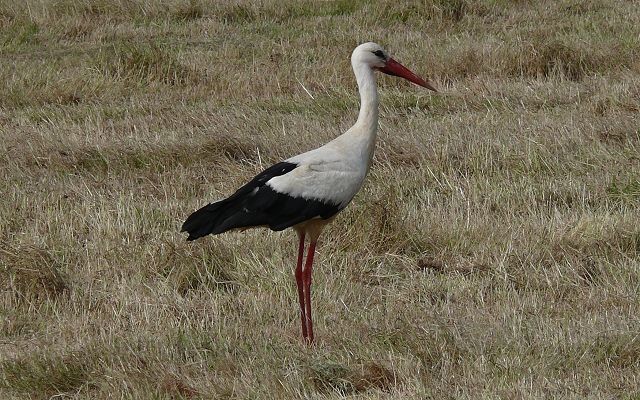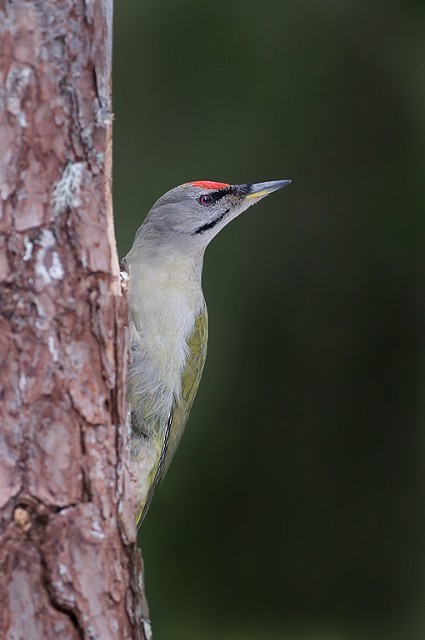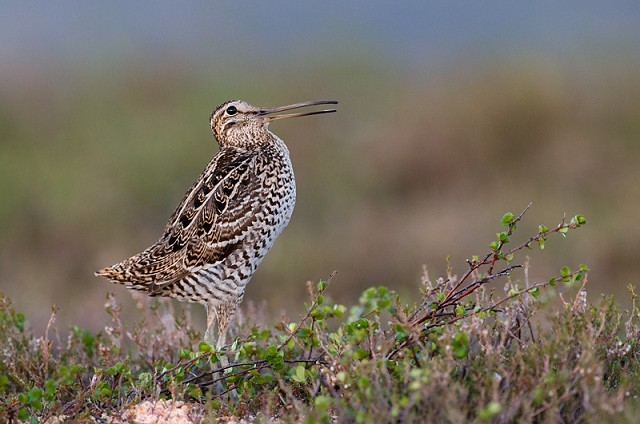The week at a glance
- Two-barred Crossbill mini-invasion in Northern Isles
- Presumed Yelkouan Shearwater in Devon
- Probable Brünnich's Guillemot in Norfolk
- Possible Booted Eagle in Dorset
As July finally decided to liven itself up from a birding point of view, for many it still feels as if (Citril Finch aside for some 50 or so twitching folk) the summer really has been a bit of a struggle so far. Sure, you have to be realistic—someone who continually expects "Firsts" will get pretty fed up with the twitching game—but the numerous counties of Britain and Ireland have been curiously "mega-free" zones for weeks now. Still, no matter, July has tried hard in its final full week as did the weather—sea frets and infrequent easterly breezes along the northeast and east coasts, the southeast at sweltering point as temperatures leapt into the high 20s and low 30s, thunderstorms unleashing themselves across many areas and the following southerly winds livening up the pelagic scene in the southwest...but the best birds of the week were, arguably, at the other end of the country.

Two-barred Crossbill, Fair Isle, Shetland (Photo: Paul King)

Two-barred Crossbill, Fair Isle, Shetland (Photo: Mark Breaks)
With the Beijing Olympics only a few days away, it seems fitting that an early game of inter-Northern Isles ping-pong developed this week as Shetland and Orkney tried their hardest to outdo each other with how many Two-barred Crossbills would appear before the Review finished for another week. After Orkney's opening gambit of the male last week, Shetland replied with one on Fair Isle on 27th, with two birds (a female and a juvenile) present there the following day (which remained to 30th). Also around Shetland, on 28th, another female was found at Sandgarth on Mainland (which remained to 29th), while on Mainland Orkney, a female was found at Mull Head, also on 28th. On 29th, two birders' gardens on Orkney were graced with single Two-barred Crossbills: one appeared at Rendall (and was still present on 30th), while another flew into a window at Crafty, was roosted overnight and released (all hale and hearty) on 30th. Shetland responded with two more birds, both on Mainland—one at Scalloway and the other at Esha Ness. So, this week it is a 5–3 Shetland win, but how many more are out there and how many more are there to come? There were some fascinating "probables" and "possibles" that are certainly worthy of a mention this week. Certainly top of the list was the presumed Yelkouan Shearwater off Berry Head (Devon) on 29th. This potential British first was watched alongside a Balearic Shearwater for 20 minutes, some 200 metres offshore, by two experienced observers, both of whom are familiar with this eastern Mediterranean species. Identification of the species is notoriously tricky though, and previous claims have struggled to get past Go in the past and field sketches and notes may not be enough to seal the record for a committee. (For more information on the species, see Martin Garner's "Identifying Yelkouan Shearwaters".) In Norfolk, a probable adult summer Brünnich's Guillemot was seen close inshore off Cley on 24th, the two observers sure of what they had seen. The most famous summer record of the species in Britain was the bird that spent almost a month on Sumburgh Head (Shetland) in June/July 1989, but this individual may make the BBRC grade too. Further reports of the bird came from Salthouse (also on 24th) and Sheringham (on 25th) but it was always distant and unproven. Finally, a "possible" Booted Eagle was seen flying over St. Catherine's Hill, Christchurch (Dorset) on 28th.

Grey Phalarope, At sea, Cork (Photo: Sean Ronayne)

Manx Shearwater, Ardrossan, Ayrshire (Photo: Dennis Morrison)
The adult White-billed Diver was seen again at St. Margaret's Hope, South Ronaldsay (Orkney) on 24th. At the start of the week, a handful of Cory's Shearwaters were noted way out towards the edge of British waters (up to 240 km southwest of Scilly), from the RRS James Cook, while on 27th, one was seen from the same vessel off Lizard Point (Cornwall). Two birds were seen from a Scilly pelagic on 28th and by 29th more and more birds were being seen, with 205 from Porthgwarra (Cornwall) in 13 hours the highest total of the week (including a feeding flock of 14 birds offshore for a couple of hours in the morning). Around Scilly, 61 Cory's flew past St. Agnes in 75 mid-afternoon minutes. On St. Mary's, 28 were seen from Peninnis Head and another dozen were seen from Deep Point, while two were seen off Tresco and an evening pelagic from St. Mary's managed four birds. In Ireland, 52 birds flew past Galley Head (Co. Cork) and in the same county five birds were seen off Cape Clear Island. On 29th, three birds were seen from Chesil Cove, Portland (Dorset) and on 30th, single-figure totals were noted from several spots around Cornwall, Scilly and County Cork, but these were the exception on a busy day for Cory's Shearwater. In Ireland, off Galley Head, 26 birds were seen in two and a half hours during the morning, and 53 birds were logged from Cape Clear Island. In Devon, 102 birds were seen off Berry Head (Devon) by mid-morning and 205 were counted from Prawle Point by 10am. Off Porthgwarra, another 170 birds were seen (in over 11 hours), but it was Lizard Point (Cornwall) that scored the highest total of the day—a sizeable 710 birds recorded in six hours. At least 25 Great Shearwaters were also seen from Lizard Point on 30th, four were seen off Porthgwarra, three were seen from Berry Head, while Cape Clear recorded five birds. Prior to 30th, numbers of Greats had been considerably smaller than those of Cory's, and had been struggling to reach double figures. The James Cook recorded three Great Shearwaters 100 km from the Jones Bank on 26th and, on the same date, one flew past Galley Head. Four birds were noted from the same site on 29th, when one was also seen from Porthgwarra. A few Sooty Shearwaters were noted during the week (mainly in ones and twos and mainly in the southwest) while Balearic Shearwaters included consecutive double-figure totals from Porthgwarra between 26th and 28th (19, 17 and 10 respectively) while 11 were seen from Berry Head on 29th with 14 there the following day, when 10 were seen from Lizard Point. Others were seen elsewhere in Cornwall, through Devon, Dorset and West Sussex, and one was seen from Collieston (Aberdeenshire) on 29th. Way off to the southwest of Scilly, the James Cook notched up a single Wilson's Storm-petrel on 25th, and one was seen from a Scilly pelagic on 28th. Most impressive though were the two birds seen from a pelagic off the north coast of Cornwall—some 18 km NNW of Padstow—on 27th. A single Leach's Storm-petrel was trapped and ringed overnight on 27th at Fife Ness (Fife). Very few Pomarine Skuas were seen this week, but two were seen from Sheringham (Norfolk) on 26th while a single Long-tailed Skua, an adult, was noted in Spey Bay (Moray) on the same date. A couple of Grey Phalaropes were seen from the James Cook on 25th and another (a moulting summer adult) was seen at sea, just a few kilometres south of Roches Point (Co. Cork) on 26th. Two of the week's Sabine's Gulls were seen on pelagic trips this week: one was seen off Seaton (Devon) on 25th and another was seen from a Scilly pelagic on 27th, while one was reported from Eyemouth (Borders) on 28th and another was off Porthgwarra on 30th.

Spoonbill, Old Moor RSPB (Dearne Valley), South Yorkshire (Photo: Andy Booth)

Glossy Ibis, Marshside RSPB, Lancashire (Photo: David Cookson)

White Stork, Wool, Dorset (Photo: Richard)
The Somerset-bred juvenile Cattle Egret continued to fare well this week and another Cattle Egret appeared at Earls Barton GPs (Northamptonshire) on 30th. Four Great White Egrets were noted this week: one was reported from Cresswell Pond (Northumberland) on 26th, singles on 27th were at Trimley Marshes (Suffolk) and at Loughor (Glamorgan) while on 28th, a Great White Egret was seen at Fota (Co. Cork). Around 25 Spoonbills were noted, with six at Minsmere (Suffolk) on 26th the highest total of the week, followed by five at Cley Marshes (Norfolk) on 24th (with four birds still present on 30th). The bird in the Dearne Valley (South Yorkshire) remained until 29th at least and one at Eyebrook Reservoir (Leicestershire) was also of note on 29th. In Scotland, two birds remained at Kinneil Lagoon (Forth) to 27th and one was seen at Kirkcudbright (Dumfries & Galloway) on 24th. A Glossy Ibis found at Ennis (Co. Clare) on 23rd was still present to 27th, while the bird at Marshside (Lancashire) was present to 26th. Then, on 27th, a Glossy Ibis flew past Spurn (East Yorkshire) before alighting along the coast at Patrington Haven. Later that afternoon, the bird moved to Sammy's Point for half an hour or so before heading off high and west (and maybe back towards the Red Rose county?). This bird was the third record of Glossy Ibis for Spurn. In Shropshire, the summering pair of Common Cranes remained near Crudgington to 29th and at Caerlaverock (Dumfries & Galloway), the lone bird was present again on 25th and 27th. A spectacular report was of some 37 Common Cranes being seen over Bierlow (South Yorkshire) on 24th—where did they end up? A White Stork was at Wool (Dorset) on 24th and another flew high over Yarm (Cleveland) on 26th, while a Black Stork was seen flying over Witcham (Cambridgeshire) on 26th.
In Somerset, the drake Ferruginous Duck was at Chew Valley Lake again on 26th–28th and another was reported from Leighton Moss (Lancashire) on 28th too. The eclipse drake Lesser Scaup remained at Balgray Reservoir (Clyde) to 29th while the eclipse drake Ring-necked Duck at Loch Gelly (Fife) was present to 30th. A drake Surf Scoter was seen from Blackdog (Aberdeenshire) on 27th and the first-summer drake King Eider was still in County Wexford this week, at Lady's Island Lake on 25th and Tacumshin on 27th. Hopeful listers still decided that the first-summer drake Hooded Merganser at Radipole Lake (Dorset) was worth a punt this week while in Kent another (presumed) "dodgy duck" was the eclipse drake Falcated Duck on a pond near Southfleet on 27th.
A Red-footed Falcon was seen for a few minutes over South Queensferry (Lothian) on 26th. Away from the traditional Honey Buzzard sites of Swanton Novers (Norfolk) and Wykeham Forest (North Yorkshire)—at least four birds here on 27th,with seven on 30th—migrants were seen at Holme (Norfolk) on 26th and over Walney Island (Cumbria) and Crimond (Aberdeenshire), both on 27th. A Montagu's Harrier was again at Gibraltar Point (Lincolnshire) on 26th–27th, and another Lincolnshire bird was seen at Freiston Shore on 25th. In Ireland, one was seen over the South Slob (Co. Wexford) on 26th.

White-rumped Sandpiper, Cresswell Pond NWT, Northumberland (Photo: Brian Bullough)

Pectoral Sandpiper, Gibraltar Point NNR, Lincolnshire (Photo: Russell Hayes)
This week's "Wader of the Week" award goes to the adult summer Pacific Golden Plover found on North Ronaldsay (Orkney) on 27th and still present to 29th at least. In Kent, a summer-plumaged American Golden Plover was at Elmley Marshes on 30th. Not far behind in the "wader of the week" stakes, if only for its impeccable timing, is the Long-billed Dowitcher at Shannon Airport Lagoon (Co. Clare). Back for the fourth summer in a row, the bird was first seen in July 2005 and has appeared in the last week of each July since. The White-rumped Sandpiper found last week at Cley Marshes NWT (Norfolk) was reported as present until 27th and, in Northumberland, another was found at Cresswell Pond NWT on 28th. At least 10 Pectoral Sandpipers were seen around Britain and Ireland this week, including two birds in Essex (still at Holland Haven CP from 24th–30th and at Hanningfield Reservoir on 29th) and two birds in Norfolk (at Cley Marshes NWT until 24th and at Titchwell on 28th–30th). Others were noted at Edderthorpe Flash (South Yorkshire) from 24th–26th, Gibraltar Point NNR (Lincolnshire) on 24th–30th, at Scaling Dam Reservoir (Cleveland) on 26th, at Port Carlisle (Cumbria) on 27th–30th while in Ireland, singles were at Dundrum Bay (Co. Down) on 25th–27th and at Kilcoole (Co. Wicklow) on 27th at least. A Temminck's Stint was at Scaling Dam on 27th with three birds at Old Hall Marshes (Essex) on 30th.

Ring-billed Gull, Nimmo's Pier, Galway (Photo: Tom Cuffe)
An adult Bonaparte's Gull was found at Castlemaine (Co. Kerry) on 30th, while the presumed American Herring Gull was again seen off and on at Chew Valley Lake (Somerset) this week and a summering Ring-billed Gull was at Nimmo's Pier (Co. Galway) on 30th. A second-summer Ring-billed Gull was found at Portrush (Co. Antrim) on 30th. A young Iceland Gull was still on St. Mary's (Scilly) this week, with a second-summer at Corbaly Road Reservoir (Co. Antrim) on 30th, while Glaucous Gulls were at Cobh (Co. Cork) on 26th, Baille an Truiseil, Lewis (Outer Hebrides) on 27th and at Fraserburgh (Aberdeenshire) on 29th. A second-summer Caspian Gull was at Minsmere (Suffolk) on 26th while three birds (two adults and a first-summer) were at Ashton-on-Trent GPs (Derbyshire) on 27th. A Polish colour-ringed first-summer Caspian Gull was at Cley Marshes NWT (Norfolk) on 30th. Following on from the Caspian Tern in Nottinghamshire last week, what may well have been the same bird was reported from Kirkby on Bain GPs (Lincolnshire) on 26th. In Suffolk, an adult Whiskered Tern flew past Sizewell on 27th while an "orange-billed" tern was seen at Kilcoole (Co. Wicklow) on 28th but sadly for those Irish listers hoping for a Lesser Crested Tern, nothing showed the following day.
Two Bee-eaters were seen over Rose Hill, Oxford on 28th and a single bird was found on mainland Orkney, at Stromness on 29th. The male Red-backed Shrike was still at Sea Palling (Norfolk) until at least 25th, while summertime Hoopoes were reported from Bishop's Castle (Shropshire) on 25th and Great Yarmouth (Norfolk) on 28th. The Shore Lark in East Yorkshire, at Spurn, was seen again on 26th.
Staying at Spurn, a Marsh Warbler was present on 28th—presumed to be a migrant—but the following day it was announced that a pair of Marsh Warblers had bred at the site and raised at least three youngsters. There was no doubting the migrant credentials of the juvenile Icterine Warbler seen on Brownsman Island, Farnes (Northumberland) on 26th–27th.
The adult male Rose-coloured Starling remained at Upper Siadar, near Barvas, Lewis (Outer Hebrides) until 29th at least with further singles noted at Deerness, Mainland (Orkney) on 28th and Dervaig, Mull (Argyll) on 30th. Rounding off the round-up this week is a Serin, seen over Pegwell Bay (Kent) on 27th.
Photo of the Week

Hobby, Summer Leys LNR, Northamptonshire (Photo: Richard Bedford)
The instant a predator catches its prey is arguably the ultimate moment to capture in wildlife photography. Advances in photographic equipment make it possible to record ever more diverse variations of this moment. Richard Bedford's action shot taken milliseconds before a Hobby grabs mating dragonflies in mid-air is an example of an image that wouldn't have been possible until recently. Taken head-on and showing the falcon with talons outstretched and using its full aerobatic ability, this is the type of image we now take for granted. Despite technological developments, though, taking photos such as this one still requires a high degree of skill and patience, even for people with Richard's level of dedication to photographing birds in action.
Other notable photos

Common Kingfisher, undisclosed site, Worcestershire (Photo: Mark Hancox)

Southern Double-collared Sunbird, South Africa (Photo: Steve Copsey)

Peregrine Falcon, Scarborough, North Yorkshire (Photo: Steve Race)

Little Grebe, Dunham Massey NT, Cheshire (Photo: David Cookson)

Spotted Redshank, Cley Marshes NWT, Norfolk (Photo: Richard Bedford)

Common Buzzard, Letham Grange, Angus & Dundee (Photo: Mark Caunt)

Eurasian Griffon Vulture, Spain (Photo: Tim Hodge)

Grey-headed Woodpecker, Norway (Photo: Terje Kolaas)

Arctic Skua, Fair Isle, Shetland (Photo: John Ball)

Skylark, Islay, Argyll (Photo: Kev Joynes)

Great Snipe, Norway (Photo: Terje Kolaas)

Dunlin, Gronant, Clwyd (Photo: Steve Round)

Common Tern, Stocker's Lake, Hertfordshire (Photo: anon)

Marsh Harrier, Cley Marshes NWT, Norfolk (Photo: Jim Almond)

